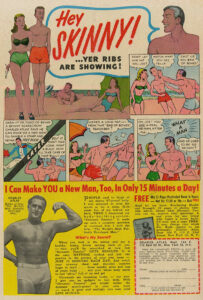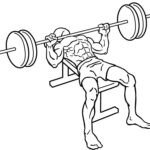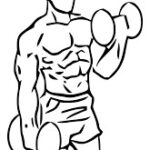The basics of fitness really aren’t that complicated. But it’s a huge industry worth billions of dollars, which results in a lot of noise and useless information to sift through.
I’m by no means an expert on this topic, but what follows is a basic framework for thinking about fitness (in particular lifting) from someone who has sifted through a lot of the useless information and made the mistakes already. It’s not intended as the optimal program (if such a thing even exists), but it will hopefully save those who are totally new to lifting some time and help them avoid scams and common mistakes.
How ‘fitness’ works
 Most people get into fitness to look better – at least that’s why I did. This is a totally fine reason, but over time your fitness goals will probably change. You will feel better and healthier, more strong and able, have more energy and improved mental health. It’s definitely more about sanity than vanity for me these days – I can’t imagine my life without some form of regular exercise.
Most people get into fitness to look better – at least that’s why I did. This is a totally fine reason, but over time your fitness goals will probably change. You will feel better and healthier, more strong and able, have more energy and improved mental health. It’s definitely more about sanity than vanity for me these days – I can’t imagine my life without some form of regular exercise.
But looking better is as good a reason as any to start. So when it comes to body composition, there are really only two things you can do:
- Gain or lose fat
- Gain or lose muscle
There is no such thing as ‘toning’. Instead, what people typically mean when they say this is that they want to gain some muscle and lose some bodyfat – and this is the same whether you are a man or a woman.
On this point: I think this myth is kind of broken now, but just in case any women reading this are worried that lifting weights will turn them into Arnold Schwarzenegger, it doesn’t work like that. Women don’t have the testosterone levels to add kilograms and kilograms of lean muscle. So, the same training principles below apply equally to men and women (although the specific muscle groups men and women focus on might differ).
Basic lifts
When starting out, the majority of your exercises should be compound movements.
Compound movements are exercises that use more than one joint and use multiple muscle groups. Isolation movements, in contrast, use only one joint.

For example, a bench press is a compound movement because it uses both the shoulder and elbow joints. It recruits muscles in the chest, shoulders, and arms simultaneously. If you wanted, you could target these muscles individually with isolation movements such as chest flies and tricep extensions – but that would take more time than doing compound movements.
Not only that, compound movements translate more to real-world actions. Sport and just everyday life involves pushing, pulling, and jumping movements. Training compound movements improves your ability to perform these common movements and trains the various muscle groups to work together.
None of this is to say isolation exercises are bad – but they are a less efficient way to train when you are starting out.

Like, I will often see people who are new to lifting just doing loads of bicep curls. Is their goal to specifically grow their bicep muscles? Or do they simply not know any other exercises and are expecting the muscle they gain to magically distribute itself evenly across their entire body? I’m really not saying this to have a go – I probably did the same sort of thing when I started out – but it’s not an effective way to train.
So, I would say compound movements should form the foundation of your lifting program. You can then add in a few isolation movements for specific body parts you want to focus on or to correct for any muscle imbalances you have.
Below are some examples of exercises (click for image) you can use to build an exercise program:
Push exercises
| Compound Exercises | Isolation Exercises |
|
|
Pull exercises
| Compound Exercises | Isolation Exercises |
Lower body exercises
| Compound Exercises | Isolation Exercises |
|
Compound movements will also go some way towards improving your core strength. And if you really want to build your abs, you can add in exercises like sit ups and leg raises too. However, how visible your abs are is much more dependent on having low body fat than how often you train them.
Sets and reps
Just in case you’ve never heard these terms before:
- Reps: How many repetitions of an exercise you do before resting
- Set: A full set of repetitions
For example, you might do 4 sets of 10 repetitions (i.e. 40 repetitions in total) of squats before moving on to another exercise.
There isn’t really a universal consensus on how many sets and reps is optimal. In general, people training for strength tend to opt for lower reps and heavier weight (e.g. 5 sets of 5 reps), whereas people training to build muscle tend to opt for higher reps and lighter weight (e.g. 4 sets of 10 reps). But both rep ranges will increase muscle size and strength.
I don’t think it matters too much what you do when you’re starting out – as long as you’re steadily progressing over time and gradually increasing the weight. I personally like 4 sets of 8-12 reps per exercise, which is pretty standard. But if you’re roughly in this sort of ballpark and progressing over time, that’s fine – you can adjust your program as you learn what works best for you.
Like sets and reps, there isn’t really a universal answer to how many exercises to do per session, but it’s somewhere around 3 to 6. I personally lean towards the lower end (3 or 4) because I go to the gym most days. But if you only go to the gym once or twice per week, you might spend longer and do 5 or 6 exercises each time you go. Again, these rules aren’t set in stone, and there is room to adapt your program to what suits you best.
What you should avoid, though, are these kind of meme exercises and social media fitness tips – stuff like this:
View this post on Instagram
I’m sure doing hundreds of reps of fire hydrants (or whatever they’re called) with resistance bands does something, but it’s far from optimal. Same with stuff like planks and bodyweight squats.
Without going too much into the science, muscles grow in response to stress. Intense training effectively damages your muscle tissue – and it is your body’s response to this damage that causes growth. Doing thousands of reps with light weights is not an effective way to create this sort of stress. Instead, to get the best results, you need to be using actual weights.
Training split
You can bring all this together to come up with a training split (i.e. training program).
A basic one for men is push/pull/legs. This split means one day you do pushing exercises, then the next session you do pulling exercises, and then the session after that you do leg exercises (then repeat). Most women would probably prefer a split with more emphasis on lower body and less on upper body, which is fine. Again, this post is just a rough framework for you to adjust to your specific goals.
Anyway, an example of a push/pull/legs split would be something like the following:
Push/pull/legs split
| Push | Pull | Legs |
|
|
|
Following this split, you might do your pushing exercises on day 1, your pulling exercises on day 2, your lower body exercises on day 3, then rest two days (for example) before repeating the cycle.
Alternatively, some people prefer a full body split. This is where you train every body part each session, and is probably a better option for people who only want to train a few times per week.
An example full body split would be something like the following:
Full body split
| Monday | Wednesday | Friday |
|
|
|
Once you’ve decided on your split, you should progress by gradually increase the weights you use over time. When 12 reps starts to feel too easy, say, you can add some extra weight to the bar until it feels challenging again.
On this point: it is much more effective to have the mindset of consistently improving over a long timeframe rather than intensely improving over a short timeframe. If you have never done any exercise ever and suddenly feel motivated to turn it all around by eating only chicken and broccoli and going to the gym 20 days in a row, that motivation probably won’t last. You won’t even get huge results anyway. Instead, it is something you have to keep chipping away at over a period of a few years.
Finally, if you’ve been doing the same split for 6 months or so, consider switching it up. Your body eventually gets used to the same old exercises.
Cardio
Many people think the point of cardio (i.e. cardiovascular exercise – stuff like running, cycling, etc.) is to lose weight. And while it can help achieve this, it’s not a very effective method for doing so.
Have you ever actually looked at how many calories you burn on a treadmill or rowing machine, for example? It takes forever to burn just 200 calories. If I push myself, I could probably burn 1000 calories in about an hour of running. But I could easily eat a large pizza or a tub of ice cream in 10 minutes – both of which are in the ballpark of 1000 calories. So, fat loss is much easier to achieve via diet than cardio.
But that is not to say cardio is a waste of time. This was my attitude for ages, but I now realise that having good cardiovascular fitness is valuable for its own sake. I hate to admit it, but good cardio is also more important for overall health than simply being able to move a lot of weight.
I would always deceive myself that I was in good shape despite doing little or no cardio for many years. I thought I felt fit, but it’s only since making cardio a regular staple of my training program that I realise how unfit I really was. As well as expected benefits like being able to run further and for longer, cardio has also given me more energy in general, improved my posture and increased my ability to recover from injuries. For example, I don’t get those weird back pains everybody gets anymore – and I put this change down to cardio. Cardio is not just an optional extra, in my view.
Note on the topic of cardio and weight loss: I’m not sure if this is obvious, but you can’t burn fat in specific areas by training them (so-called spot reduction). Whereas you can influence the areas you gain muscle by focusing on those areas specifically, you can’t influence the areas where your body stores or burns fat – that is determined by genetics.
Diet and supplements
Diet is really important. But like so much in health and fitness, there is no universal consensus on what the optimal diet is. However, there are some general principles that most people would agree on.
As mentioned above, there are two axes for body composition: bodyfat and muscle. However, gaining muscle and losing fat are somewhat mutually exclusive – you can really only optimise for one of these goals at a time. Which of these goals you achieve will be determined by your diet and how many calories you eat.
If your goal is to gain muscle, you should eat around 250 calories more than your total daily energy expenditure (TDEE), which you can calculate below. If your goal is to lose bodyfat, you should eat around 250 calories less than your TDEE.
Some people ‘count’ calories and try to be really precise about this sort of stuff, but I personally find this way too much effort – especially when these calculations aren’t particularly accurate anyway. Instead, it’s fine to have a rough idea of your energy expenditure and calorie intake and go by that. If you pay attention to what you eat and listen to your body, you will develop an intuitive understanding of this stuff that is pretty reliable.
You can then break your calories down by their macronutrient composition. The macronutrients are:
- Carbohydrates
- Fats
- Protein
There is a bit of an obsession with protein in fitness, but that’s because it really is important. You can’t recover and build muscle without protein.
A common figure thrown around is that you should aim for 1 gram of protein per 1 pound of bodyweight (roughly 2 grams per kilogram of bodyweight) each day in order to gain muscle. In my experience, this is probably a bit high – but it’s a good ballpark to aim for. You won’t get any benefits by increasing protein intake beyond this, though.
Note on protein: although there are different kinds of proteins (i.e. different amino acid composition), there is no difference between protein from protein shakes and protein from food. You don’t have to supplement with protein shakes or protein bars or whatever if you’re getting enough protein from elsewhere in your diet.
The optimal ratio of carbs and fats is a bit more of a controversial topic. Some people swear by low- or zero-carb diets, whereas others argue that this is unhealthy.
My own experience suggests the typical ‘Western’ diet (as often encouraged by health authorities) contains too many sugars and fast-digesting carbohydrates. This is not to say that ketogenic or even low carbohydrate diets are best, but I do think eating processed cereals with milk for breakfast and white bread sandwiches for lunch is probably not a good idea.

When it comes to fats, it’s tempting to think eating fat = bad, but that’s not true. Firstly, eating zero fat would be really unhealthy. Secondly, there are different kinds of fats. It’s not worth going into detail on the differences here, but common sense is a pretty good guide to which are healthy: ice cream and pies are high in fat, so are avocados and nuts. Don’t assume that low fat = healthy.
In addition to macronutrients, you also have micronutrients – these are things like vitamins and minerals.
Like with all aspects of health and fitness, you can obsess about minor details (Am I getting enough zinc? Do I need to supplement magnesium? Etc.) but as long as you are eating plenty of fresh fruit and vegetables, you are probably not deficient in any of these. There are a few exceptions to this (for example, people in northern climates will probably benefit from supplementing vitamin D3 in winter), but if you eat a healthy diet already, the effects of supplementing extra vitamins will be minor at best.
There aren’t any over-the-counter supplements or vitamins that you absolutely need to make gains. Things like protein shakes, creatine, and pre-workouts might be somewhat useful, but they are not magic potions. There aren’t any secret supplements other than anabolic steroids, but that’s a whole other story.
In summary
- Exercise:
- Do mostly compound movements (like squats, bench press, and rows) with a weight that you can control for 8-12 reps
- Gradually increase the weight whenever 12 reps becomes easy
- Aim to train each body part at least once per week, but don’t train areas if they are still sore from the previous session
- Don’t skip cardio, but don’t feel you have to spend ages on it either (unless you are training for endurance)
- Switch up your training split every 6 months or so when it gets stale
- Diet:
- Be conscious of macronutrients and aim for 1g of protein per 1lb of bodyweight per day (but don’t obsess over it)
- Eat ~250kcal over daily maintenance to gain muscle
- Eat ~250kcal under daily maintenance to lose fat
- Use common sense and eat plenty of vegetables for micronutrients
- In general, aim for consistency over a long timeframe rather than intensity over a short timeframe
- Enjoy and have fun 🙂
“No man has the right to be an amateur in the matter of physical training. It is a shame for a man to grow old without seeing the beauty and strength of which his body is capable.”
– Quote from Socrates, apparently. Although it might just be one of those misattributed internet quotes.